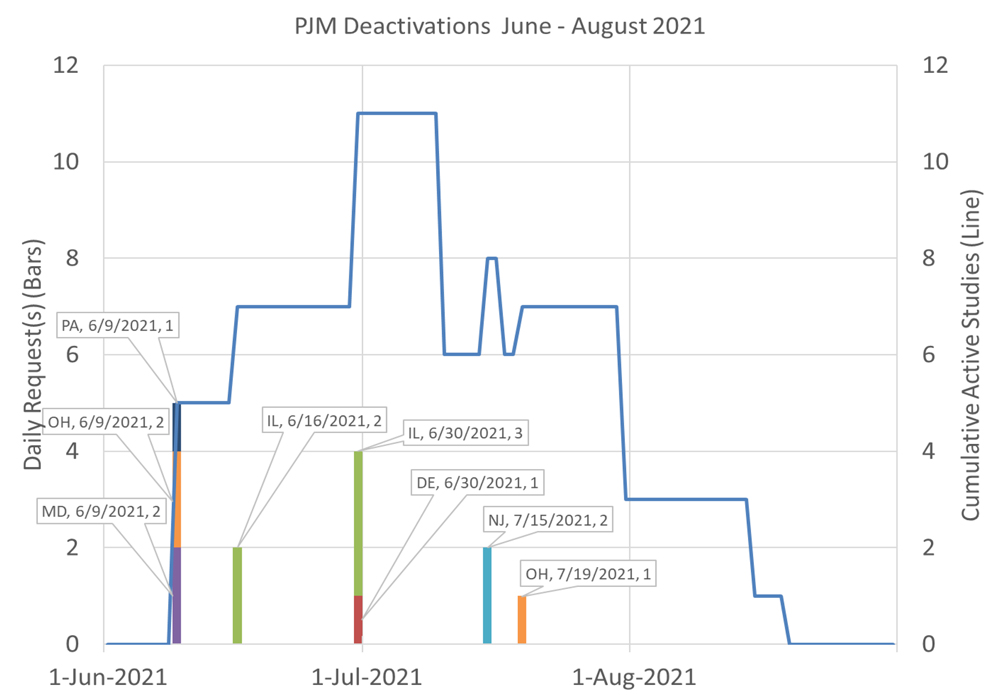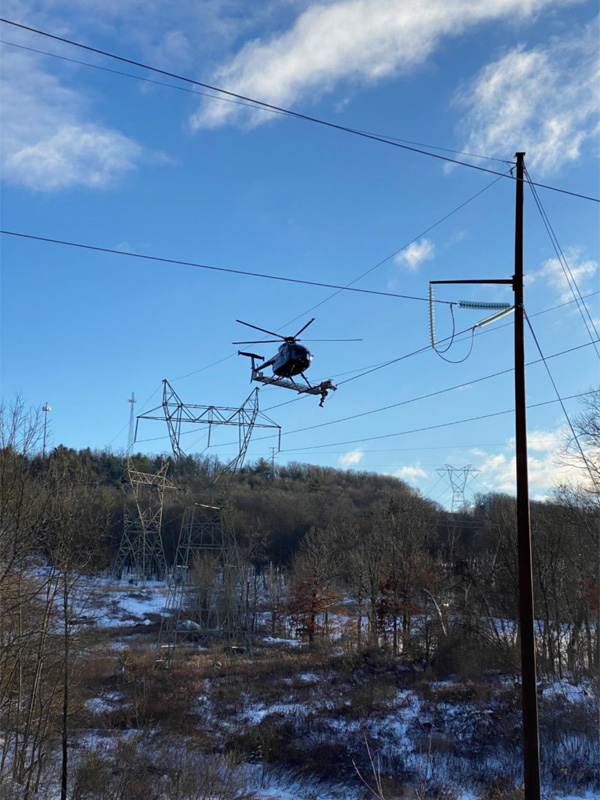
Markets and Reliability Committee
Clean Attribute Procurement Task Force Established
PJM stakeholders at last week’s Markets and Reliability Committee meeting endorsed an issue charge creating a new senior task force to study a potential market construct for procuring clean resource attributes in the RTO’s markets.
The issue charge, which was developed in the Resource Adequacy Senior Task Force (RASTF) over several months of debate, was endorsed with a sector-weighted vote of 3.513 (70.2%), surpassing the necessary 2.5 threshold.
Dave Anders, director of stakeholder affairs for PJM, reviewed a revised issue charge from the RASTF, saying the first key work activity in the original called for determining whether the “forward procurement of clean resource attributes” should be pursued by stakeholders and examining the inclusion of the social cost of carbon in PJM markets. He said 70% of RASTF members endorsed pursuing a new issue charge calling for a “comprehensive discussion of market enhancements” that would enable states and other buyers to procure clean resource attributes “on a voluntary basis, through a regional and centralized procurement or market.”
 The last in-person PJM Annual Meeting was held in 2019 at the Hyatt Regency Chesapeake Bay Golf Resort, Spa & Marina in Cambridge, Md. | © RTO Insider LLC
The last in-person PJM Annual Meeting was held in 2019 at the Hyatt Regency Chesapeake Bay Golf Resort, Spa & Marina in Cambridge, Md. | © RTO Insider LLCWork will start in the new Clean Attribute Procurement Senior Task Force with education on the procurement of clean resource attributes, including defining clean resource attributes across jurisdictions, markets and procurement mechanisms. The second step calls for discussing the objectives of a market construct to enable voluntary procurement of clean resource attributes.
PJM and stakeholders will determine an approach to conduct analysis and select one or more market design solutions for further development. Expected deliverables in the issue charge include proposed market rules to implement the preferred design, if one is found.
“The universe of high-level approaches could vary very widely,” Anders said.
Denise Foster Cronin of the East Kentucky Power Cooperative (EKPC) proposed a friendly amendment to the issue charge, adding language delineating that “for any market design endorsed by the MRC,” stakeholders will conduct a “detailed design and develop market rules for implementation.”
“It’s not intended to be a substantive change to the work that’s going to be undertaken,” Foster Cronin said.
Greg Poulos, executive director of the Consumer Advocates of the PJM States, objected, saying that some of the advocates were “concerned” that the amendment could “add delay or extra layers of steps to the process.”
The amendment was not adopted in the endorsed issue charge.
Chris Pilong, senior director of operations planning, and Alex Scheirer, senior client manager for PJM, also provided an update on the Operating Committee’s recommendation regarding additional reliability products and services related to the issue charge. The OC approved an initial recommendation at its April 14 meeting for the evaluation of adding more reliability-based generation as greater numbers of intermittent resources are integrated into PJM’s grid. (See “Reliability Products and Services Assessment Endorsed,” PJM Operating Committee Briefs: April 14, 2022.)
Deactivation Process Timing Update Endorsed
Members endorsed a PJM proposal to update the process timing for generation deactivations, with one stakeholder voting against it.
David Egan, manager of PJM’s system planning modeling and support department, reviewed the proposal and presented the revisions to Manual 14D and the tariff.
Current tariff language provides 90 days advance notice and 30 days to complete deactivation studies, which Egan said is causing “insufficient and unsustainable” time for PJM staff to determine adverse impacts on reliability if more than one deactivation notice is made in a single study period. New state energy policies are also adding to the number of deactivations, creating more pressure on PJM staff to finish studies.
 Example of a generation deactivation timeline in PJM from June-August 2021. | PJM
Example of a generation deactivation timeline in PJM from June-August 2021. | PJM
The proposal calls for establishing quarterly study times for requests, with periods beginning Jan. 1, April 1, July 1 and Oct. 1. PJM staff would study deactivations in batches for more accurate results for the impacts on the system. Egan said the quarterly schedule would allow enough time for additional required seasonal, interim year and short-circuit analyses; scheduling upgrades and cost estimates; and for PJM operations to identify additional needed operational measures.
Paul Sotkiewicz of E-Cubed Policy Associates thanked PJM for working with stakeholders to amend some of the tariff language that creates exemptions so that generation owners aren’t penalized if a unit is forced to deactivate through state legislation or actions by the federal government.
Stakeholders will vote on final endorsement of the proposal at the Members Committee meeting May 17. Conforming Manual 14D language will also go through the OC and System Operations Subcommittee.
Dynamic Line Ratings
PJM provided a first read of the RTO’s proposal and manual revisions supporting the interim integration of dynamic line ratings (DLRs) into its operations.
Stakeholders unanimously approved an issue charge and endorsed a proposed solution as part of the “quick fix” process at last month’s Planning Committee meeting. (See “Dynamic Rating Issue Endorsed,” PJM Operating Committee Briefs: April 14, 2022.)
 A PPL helicopter crew installs dynamic line rating sensors on transmission lines. | PPL
A PPL helicopter crew installs dynamic line rating sensors on transmission lines. | PPLChris Callaghan, PJM senior business solution engineer, reviewed the proposal. PPL is tentatively scheduled to go live in June with a DLR system on some of its transmission lines, Callaghan said, and PJM wanted to “enable the operational implementation of dynamic ratings” through temporary manual revisions, which will be in place pending submission of the RTO’s FERC Order 881 compliance filing, scheduled to be finalized this month.
In December, FERC ordered transmission providers to end the use of static line ratings in evaluating near-term transmission service and required transmission providers to employ ambient-adjusted ratings for short-term transmission requests of 10 days or less for all lines that are impacted by air temperature. (See FERC Orders End to Static Tx Line Ratings.)
Bilge Derin, PJM senior engineer, reviewed the language changes in Manual 1: Control Center and Data Exchange Requirements, Manual 3: Transmission Operations and Manual 3A: Energy Management System (EMS) Model Updates and Quality Assurance (QA). Derin said the language revisions develop new guidance and requirements related to the operational and technical implementation of dynamic rating systems.
Some of the manual revisions include adding timeline requirements to notify PJM about any new DLR systems to be installed on the grid and to provide details on requirements for real-time and forecasted DLR submissions.
“Our goal with the timeline requirement is to provide for both PJM and other stakeholders to be aware of the implementation and be prepared for it as well,” Derin said.
Susan Bruce, counsel to the PJM Industrial Customer Coalition, said she appreciated PJM and PPL “looking at ways to get more out of existing transmission assets.”
Consent Agenda
Stakeholders unanimously endorsed several items, including manual, Operating Agreement and task force charter revisions, as part of the MRC consent agenda. They included:
- revisions to Manual 1: Control Center and Data Exchange Requirements resulting from a periodic review and revisions to NERC standards CIP-012, COM-001 and EOP-008.
- revisions to Manual 14F: Competitive Planning Process resulting from a periodic review. The changes included updating language so that the Secure File Transfer Tool used to submit all proposals was replaced with a requirement to use “Competitive Planner” to submit proposals.
- revisions to the OA intended to appropriately document the underfrequency load shedding (UFLS) relay requirements applicable to EKPC. A recent review of revisions showed “potential confusion” in EKPC’s appropriate UFLS requirement that needed to be corrected.
- revisions to the Energy Price Formation Senior Task Force charter. The proposed charter edits relate to the delay in reserve price formation implementation, from May 1 to Oct. 1.
Members Committee
Definition of Workshops
Members are looking to add a definition of “workshops” to the PJM manual to better explain their purpose in the stakeholder process.
At last week’s Members Committee meeting, John Horstmann, director of RTO affairs at AES Ohio, presented the proposed revisions to Manual 34: PJM Stakeholder Process. The language was partially developed at the Stakeholder Process Forum.
The proposed definition states that workshops are “a series of meetings occasionally convened by PJM to discuss emerging topics and objectives as outlined in its initial communication and meeting. Workshops are non-decisional meetings and will not develop rule changes. Rather, they are formed to engage in education, foster dialogue, share ideas and gather stakeholder feedback.”
Calpine’s David “Scarp” Scarpignato thanked PJM and Horstmann for the work on coming up with a clear definition, saying it was “much needed.”
“They’re getting used more and more often, and it adds some clarity around these things,” Scarp said.
Remote Voting Endorsed
Stakeholders unanimously endorsed revisions to Manual 34 to allow for remote voting for the Board of Managers election at the PJM Annual Meeting on May 17.
Previous manual language requires written paper ballots for the elections of board members and the Members Committee vice chair. The revisions to Manual 34 strikes that language.
PJM said it identified the need to “exercise flexibility” to conduct the 2020 and 2021 board elections because of precautions surrounding the COVID-19 pandemic.
The 2020 board election was done remotely through the PJM Voting Application with special auditing provisions, and the 2021 board election was conducted through a secure, third-party online election service, Survey & Ballot Systems.PJM is continuing to use a secure third-party voting system for stakeholders not attending the Annual Meeting in person.

